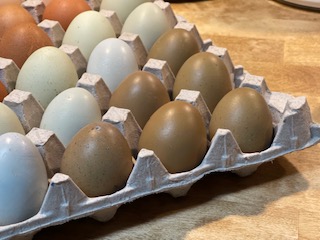How to grow your Olive Egger flock

Somehow it never gets old— opening the nesting boxes to discover the delight of a range of eggs in every shade and speckle imaginable.
Black Copper Marans over Ameraucana
Perhaps the classic olive egg, a Black Copper Marans rooster bred for dark chocolate egg color genetics over the blue egg-laying Ameraucana is an F1 olive egg. At Crosshatch Farm, this cross results in big, heavily muffed birds that are docile and consistently lay olive eggs somewhere around an army green. Occasionally these olive eggs will have a bloom that makes them appear to be gray or pink.
It’s true! Darker Olives will come of a dark-egged genetics BCM rooster over an Ameraucana hen
If darker olives are your goal, you’ll need a dark-egg genetics cock over your blue egg layer— cocks carry egg color genes while hens carry body type and tail angle!
Welsummer over Legbar
At Crosshatch Farm we tend to think that Welsummers are a better match for the size of our Legbar hens— a smaller blue egg layer with a mohawk feather tuft and a floppy comb. Our Welsummer over legbar crosses generate speckled olive eggs somewhere between the color of seafoam and moss that often have interesting ombre patterns and ink jams. This is one of our favorite crosses!
F1 or BC1?
Genetics shorthand can be confusing! F1 means a first generation or filial cross, such as the two detailed above. But breeding for egg color doesn’t stop there. Many colorful bronze, maize, and pea green eggs come of experimenting with back crosses— where the offspring of an F1 cross is put back under the same cock of the same type. This consolidates the color genetics further, leading to exaggerated colors, speckles, and blooms. You can also breed a cross to another cross (F2) or even return the hens of later generations back to the original cock (F2-F8, for example).
If you want a guaranteed olive egg, stick with an F1 cross as detailed above. If you’re ready for some color variety in your basket and don’t mind the occasional brown egg layer that comes of later crosses, experiment with a mixed flock of F2s and BC2s!